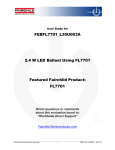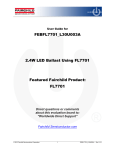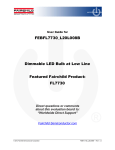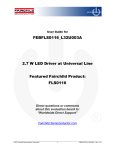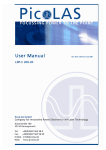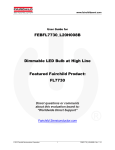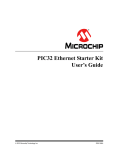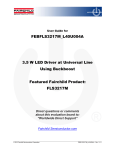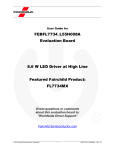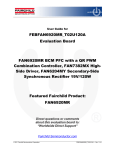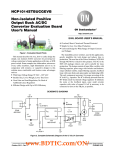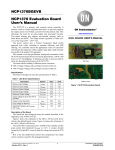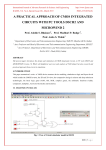Download User Guide for FEBFL7701_L34U018A Evaluation Board
Transcript
User Guide for FEBFL7701_L34U018A Evaluation Board Universal Line Voltage LED Ballast Featured Fairchild Product: FL7701 Direct questions or comments about this evaluation board to: “Worldwide Direct Support” Fairchild Semiconductor.com © 2012 Fairchild Semiconductor Corporation 1 FEBFL7701_L34U018A • Rev.1.0.1 Table of Contents 1. Introduction ............................................................................................................................... 3 1.1. 1.2. 1.3. General Description ......................................................................................................... 3 Features ............................................................................................................................ 3 Internal Block Diagram.................................................................................................... 4 2. General Specifications for Evaluation Board ........................................................................... 5 3. Photographs............................................................................................................................... 6 4. Printed Circuit Board ................................................................................................................ 6 5. Schematic .................................................................................................................................. 7 6. Bill of Materials ........................................................................................................................ 8 7. Performance of Evaluation Board ............................................................................................. 9 7.1. 7.2. 7.3. 7.4. 7.5. 7.6. 7.7. 7.8. 7.9. 7.10. Typical Waveforms: Startup .......................................................................................... 10 Operating Frequency & Minimum Duty........................................................................ 11 Typical Waveforms: Steady State .................................................................................. 12 Typical Waveforms: Abnormal Mode (LED-Open)...................................................... 15 Typical Waveforms: Abnormal Mode (Inductor Short) ................................................ 16 System Efficiency .......................................................................................................... 17 Power Factor at Rated Load Condition .......................................................................... 18 THD Performance at Rated Load Condition ................................................................. 19 Thermal Performance at Rated Load Condition ............................................................ 20 Electromagnetic Interference (EMI) Result ................................................................... 22 8. Revision History ..................................................................................................................... 24 © 2012 Fairchild Semiconductor Corporation 2 FEBFL7701_L34U018A • Rev. 1.0.1 This user guide supports the evaluation kit for the FL7701, FEBFL7701_L34U018A. It should be used in conjunction with the FL7701 datasheets as well as Fairchild’s application notes and technical support team. Please visit Fairchild’s website at www.fairchildsemi.com. 1. Introduction This document describes the proposed solution for a universal input 18.3 W LED ballast using the FL7701. The input voltage range is 90 VRMS – 264 VRMS and there is one DC output with a constant current of 470 mA at 39 VMAX. This document contains general description of FL7701, the power supply specification, schematic, bill of materials, and the typical operating characteristics. 1.1. General Description The FL7701 LED lamp driver is a simple IC with a Power Factor Correction (PFC) function. The special “adopted digital” technique of the IC can automatically detect input voltage condition Zero-Crossing Detector (ZCD) and send a internal reference signal for high power factor. When AC input is applied to the IC, PFC function is automatically enabled. When DC input is applied to the IC, PFC function is automatically disabled. The FL7701 does not need a bulk capacitor (electrolytic capacitor) for supply rails stability, which can significantly affect to LED lamp system. 1.2. Features Digitally Implemented Active PFC Function (No Additional Circuit Necessary for High PF) Built-in HV Supplying Circuit: Self Biasing AOCP Function with Auto-Restart Mode Built-in Over-Temperature Protection (OTP) Cycle-by-Cycle Current Limit Low Operating Current: 0.85 mA (Typical) Under-Voltage Lockout with 5 V Hysteresis Programmable Oscillation Frequency Programmable LED Current Analog Dimming Function Soft-Start Function Precise Internal Reference: ±3% © 2012 Fairchild Semiconductor Corporation 3 FEBFL7701_L34U018A • Rev. 1.0.1 1.3. Internal Block Diagram 8 VCC 3 HV JFET VCC ZCD UVLO time IAD ADIM ZCD 5 DAC TSD Soft-Start Digital Block RT 4 Oscillator - 2 OUT Q R S Reference + 1 LEB CS Leading-Edge Blanking GND 6 + AOCP 2.5V Figure 1. Block Diagram Table 1. Pin Definitions Pin Name 1 CS 2 OUT Output. Connects to the MOSFET gate. 3 VCC Supply Voltage. Supply pin for stable IC operation; ZCD signal detection used for accurate PFC function. 4 RT Resistor. Programmable operating frequency using an external resistor connected to this PIN and the IC has fixed frequency when this pin is left open or floating. 5 ADIM Analog Dimming. Connects to the internal current source and can change the output current using an external resistor. If ADIM is not used, connect a 0.1 µF bypass capacitor between ADIM and GND. 6 GND GROUND. Ground for the IC. 7 NC No Connection 8 HV High Voltage. Connect to the high-voltage line and supply current to the IC © 2012 Fairchild Semiconductor Corporation Description Current Sense. Limits output current, depending on the sensing resistor voltage. The CS pin is also used to set the LED current regulation. 4 FEBFL7701_L34U018A • Rev. 1.0.1 2. General Specifications for Evaluation Board All data for this table was measured at an ambient temperature of 25°C. Table 2. Summary of Features and Performance Description Input Voltage Range AC Input Frequency Output Voltage Output Current(1) (2) Output Power Symbol Value Comments VIN.MIN 90 V Minimum Input Voltage VIN.NORMAL 110 V / 220 V Normal Input Voltage VIN.MAX 264 V Maximum Input voltage fIN.MIN 47 Hz Minimum Input Frequency fIN.MAX 64 Hz Maximum Input Frequency VOUT,MAX 41 V Maximum Output Voltage VOUT,NORMAL 39 V Normal Output Voltage VOUT,MIN 37 V Minimum Output Voltage IOUT.NORMAL 470 mA Normal Output Current CC deviation < ±4.5% Line Input Voltage Change: 90~264 VAC Output Power 18.3 W Efficiency >83% < 63°C TFL7701 Temperature At Full Load TDM filter < 69°C TFRD,ES3J < 61°C TMOSFET < 68°C Tinductor < 50°C At full load (all at open-frame, room temperature / still air) PCB Size 18 mm (width) x 295 mm (length) x 10mm (height) Initial Application L-Tube Notes: 1. The output current has ILEDPK ripple. To reduce ripple current, use a large electrolytic capacitor in parallel with the LED. Ensure the capacitor voltage rating is high enough to withstand an open-LED condition or use a Zener diode for protection. 2. The output power is not equal to the apparent power due to the slight phase shift between the output voltage and current. © 2012 Fairchild Semiconductor Corporation 5 FEBFL7701_L34U018A • Rev. 1.0.1 3. Photographs Figure 2. Top View, Length: 295mm Figure 3. Width: 18mm Figure 4. Height: 10mm (Include PCB) 4. Printed Circuit Board Figure 5. Top Side (18mm x 295mm) Figure 6. Bottom Side (18mm x 295mm) © 2012 Fairchild Semiconductor Corporation 6 FEBFL7701_L34U018A • Rev. 1.0.1 5. Schematic Figure 7. Schematic © 2012 Fairchild Semiconductor Corporation 7 FEBFL7701_L34U018A • Rev. 1.0.1 6. Bill of Materials Item No. Part Reference Part Number Qty. Description Manufacturer 1 U1 FL7701 1 Controller Fairchild Semiconductor 2 Fuse SS-5-1A 1 1 A / 250 V Fuse Cooper Bussmann 3 MOV MOV-10D471K 1 VARISTOR 470 V 10MM RADIAL Bourns Inc. 4 L1 LF-1480-253 1 Line Filter Sejin Telecom (www.sejintel.com) 5 L2, L3 RFB0810-472 2 4.7 mH Inductor Coil Craft 6 L4, L5 PCH-45x-475 2 4.7 mH Inductor Coil Craft 7 BD DF04S 1 400 V / 1.5 A, Bridge Rectifier Fairchild Semiconductor 8 D1 1N4148 1 100 V / 200 mA, Small Signal Diode Fairchild Semiconductor 9 D2 RS1M 1 1000 V / 1 A, Fast Rectifier Fairchild Semiconductor 10 D3 ES3J 1 600 V / 3 A, Fast Rectifier Fairchild Semiconductor 11 ZD1 MMSZ5230B 1 4.7 V / 0.5 W Zener Diode Fairchild Semiconductor 12 Q1 FQD2N60 1 2 A / 600 V MOSFET Fairchild Semiconductor 13 Q2 FQN1N50C 1 1 A / 500 V MOSFET Fairchild Semiconductor 14 C1 PCX2 335M MKP 100nF 1 100 nF / 275 VAC, X-Cap PILKOR 15 C2 MPE 630V104K 1 0.1 µF / 630 VAC, 10%, Polypropylene Sungho 16 C3 MPE 400V334K 1 17 C4, C5 C1206C225K5PACTU 2 2.2 µF / 50V SMD Capacitor 3216 Kemet 18 C6 C0805C104K3RACTU 1 0.1 µF / 25V SMD Capacitor 2012 Kemet 19 C7 C1206C102K5PACTU 1 1 nF / 50V SMD Capacitor 3216 Kemet 20 C8 C1206C105K5PACTU 1 1 µF / 50 V SMD Capacitor 3216 Kemet 21 C9 KMG 330 µF / 63 V 1 330 µF / 63 V Electrolytic Capacitor SamYoung 22 R1, R2 RC1106JR-07151RL 2 150 RES, SMD, 1/4W, 3216 Yageo 23 R3 RC0805JR-07331RL 1 330 RES, SMD, 1/8W, 2012 Yageo 24 R4, R5 RC1106JR-070R9RL 2 0.9 RES, SMD, 1/4W, 3216 Yageo 25 R6 RC1106JR-07204RL 1 200 k RES, SMD, 1/4W, 3216 Yageo 26 R7 RC1106JR-07153RL 1 15 k RES, SMD, 1/4W, 3216 Yageo 27 R8 RC0805JR-07823RL 1 82 k RES, SMD, 1/8W, 2012 Yageo 28 R9 10.0KBZTB-ND 1 10 k / 1 W Resistor Yageo 29 R10 RC1106JR-07000RL 1 0 RES, SMD, 1/4W, 3216 Yageo © 2012 Fairchild Semiconductor Corporation 0.33 µF / 400 VAC, 10%, Polypropylene 8 Sungho FEBFL7701_L34U018A • Rev. 1.0.1 7. Performance of Evaluation Board Table 3. Test Condition & Equipments Test Temperature Test Equipment © 2012 Fairchild Semiconductor Corporation TA = 25°C, Open-Flame AC Source : PCR500L by Kikusui Power Meter : PZ4000 by Yokogawa Oscilloscope : waverunner 64Xi by Lecroy EMI Test Receiver: ESCS30 by ROHDE & SCHWARZ Two-Line V-Network: ENV216 by ROHDE & SCHWARZ Thermometer : CAM SC640 by FLIR SYSTEMS LED: EHP-AX08EL/GT01H-P03 (3W) by Everlight 9 FEBFL7701_L34U018A • Rev. 1.0.1 7.1. Typical Waveforms: Startup Figure 8 through Figure 11 show the typical startup performance at different input voltage conditions. When AC input voltage is applied to the system, the FL7701 automatically operates in AC Mode after finishing an internally fixed, seven-cycle, soft-start period. Figure 8. Soft-Start Characteristics at 90 VAC (47 Hz ) CH2: VOUT, CH3: VDRAIN, CH4: IINDUCTOR Figure 9. Soft-Start Characteristics at 264 VAC (47 Hz), CH2: VOUT, CH3: VDRAIN, CH4: IINDUCTOR Figure 10. Soft-Start Characteristics at 90 VDC (64 Hz), CCH2: VOUT, CH3: VDRAIN, CH4: IINDUCTOR Figure 11. Soft-Start Characteristics at 264 VDC (64 Hz), CCH2: VOUT, CH3: VDRAIN, CH4: IINDUCTOR © 2012 Fairchild Semiconductor Corporation 10 FEBFL7701_L34U018A • Rev. 1.0.1 7.2. Operating Frequency & Minimum Duty The recommended switching frequency of FL7701 is around 20 kHz ~ 250 kHz and it is determined by the RT resistor and has prefixed output frequency in RT-open condition. The maximum duty ratio is fixed below 50% and pre-fixed minimum on time is around 400 ns. There are two considerable points to design properly. The first, consider the minimum duty at low input voltage because the FL7701 cannot get higher than 50% duty ratio. This means the FL7701 should have duty margin. The other is minimum on-time at high input voltage condition. The FL7701 cannot control output power when the set point is smaller than on time at very high input voltage. On-time margin must be considered. Minimum On Time: 5.2 µs Switching Frequency: 21.72 kHz Figure 12. Operating Frequency & Minimum Duty CH2: VOUT, CH3: VDRAIN, CH4: IINDUCTOR © 2012 Fairchild Semiconductor Corporation 11 FEBFL7701_L34U018A • Rev. 1.0.1 7.3. Typical Waveforms: Steady State Figure 13 through Figure 22 show the normal operation waveforms by input voltage and input frequency. The output voltage and current always keeps a certain output level with (input frequency ×2) ripple and the test results are provided in Table 5. Figure 13. Input Voltage: 90 VAC, Input Frequency: 47 Hz, CH2: VOUT, CH3: VDRAIN, CH4: ILED Figure 14. Input Voltage: 90 VAC, Input Frequency: 64 Hz, CH2: VOUT, CH3: VDRAIN, CH4: ILED Figure 15. Input Voltage: 110 VAC, Input Frequency: 47 Hz, CH2: VOUT, CH3: VDRAIN, CH4: ILED Figure 16. Input Voltage: 110 VAC, Input Frequency: 64 Hz, CH2: VOUT, CH3: VDRAIN, CH4: ILED © 2012 Fairchild Semiconductor Corporation 12 FEBFL7701_L34U018A • Rev. 1.0.1 Figure 17. Input Voltage: 180 VAC, Input Frequency: 47 Hz, CH2: VOUT, CH3: VDRAIN, CH4: ILED Figure 18. Input Voltage: 180 VAC, Input Frequency: 64 Hz, CH2: VOUT, CH3: VDRAIN, CH4: ILED Figure 19. Input Voltage: 220 VAC, Input Frequency: 47 Hz, CH2: VOUT, CH3: VDRAIN, CH4: ILED Figure 20. Input Voltage: 220 VAC, Input Frequency: 64 Hz, CH2: VOUT, CH3: VDRAIN, CH4: ILED Figure 21. Input Voltage: 264 VAC, Input Frequency: 47 Hz, CH2: VOUT, CH3: VDRAIN, CH4: ILED Figure 22. Input Voltage: 264 VAC, Input Frequency: 64 Hz, CH2: VOUT, CH3: VDRAIN, CH4: ILED © 2012 Fairchild Semiconductor Corporation 13 FEBFL7701_L34U018A • Rev. 1.0.1 IO [A] 0.52 0.51 0.5 0.49 0.48 0.47 0.46 0.45 0.44 0.43 0.42 47Hz 64Hz 90Vac 110Vac 180Vac 220Vac 264Vac Figure 23. CC Deviation Curve Table 4. Output Characteristics by Input Voltage & Frequency 47 Hz 64 Hz VLED(RMS) (V) ILED(RMS) (mA) VLED(RMS) (V) ILED(RMS) (mA) 90 VAC 37.73 468.2 37.78 451.6 110 VAC 38.07 487.6 38.13 475.7 180 VAC 38.25 489.4 38.23 481.4 220 VAC 38.25 485.6 38.26 478.7 264 VAC 38.18 482.1 38.20 475.4 Deviation © 2012 Fairchild Semiconductor Corporation 4.33% 14 6.19% FEBFL7701_L34U018A • Rev. 1.0.1 7.4. Typical Waveforms: Abnormal Mode (LED-Open) Figure 24 shows the open-load condition test method. If the LED disconnects from the system, the output voltage increases up to match the voltage of the input source. Add the output voltage clamping circuit or the special protection circuit to protect components, especially output capacitor. Figure 24. Open-LED Condition The Figure 25 shows the test results of waveform in LED-open condition; the output voltage clamps a certain level. Figure 25. Output Waveforms at LED-OPEN Condition CH2: VOUT, CH3: VDRAIN, CH4: ILED © 2012 Fairchild Semiconductor Corporation 15 FEBFL7701_L34U018A • Rev. 1.0.1 7.5. Typical Waveforms: Abnormal Mode (Inductor Short) Figure 26 and Figure 27 show the test method and result of an inductor short. The FL7701 uses an Abnormal Over-Current Protection (AOCP) function, limiting the current on RCS in the event of an inductor short. Figure 26. Inductor Short Condition Figure 27. Test Result of Inductor Short Condition CH2: VOUT, CH3: VDRAIN, CH4: ILED © 2012 Fairchild Semiconductor Corporation 16 FEBFL7701_L34U018A • Rev. 1.0.1 7.6. System Efficiency Figure 28 shows system efficiency results for different AC input voltage frequency conditions. As shown, the input frequency has negligible effect on system efficiency. Efficiency VIN Figure 28. System Efficiency Table 5. Test Result of System Efficiency Input Voltage 90 VAC 110 VAC 180 VAC 220 VAC 264 VAC © 2012 Fairchild Semiconductor Corporation Efficiency (%) 47 Hz 83.63 64 Hz 83.55 47 Hz 86.18 64 Hz 86.06 47 Hz 88.52 64 Hz 88.56 47 Hz 88.58 64 Hz 88.52 47 Hz 87.53 64 Hz 87.51 17 FEBFL7701_L34U018A • Rev. 1.0.1 7.7. Power Factor at Rated Load Condition Figure 29 shows the system Power Factor (PF) performance for the entire input voltage range (90 VAC to 264 VAC) at different input frequency conditions (47 Hz, 64 Hz). The PF changes slightly according to the input frequency. PF VIN Figure 29. Power Factor Table 6. Power Factor Test Results Input Voltage 90 VAC 110 VAC 180 VAC 220 VAC 264 VAC © 2012 Fairchild Semiconductor Corporation Power Factor 47 Hz 0.95 64 Hz 0.95 47 Hz 0.96 64 Hz 0.96 47 Hz 0.94 64 Hz 0.93 47 Hz 0.91 64 Hz 0.90 47 Hz 0.88 64 Hz 0.85 18 FEBFL7701_L34U018A • Rev. 1.0.1 7.8. THD Performance at Rated Load Condition Figure 30 shows the Total Harmonic Distortion (THD) performance at different input frequencies. Test results are similar; THD meets international regulations (under 30%). THD VIN Figure 30. Total Harmonic Distortion Performance Table 7. THD Test Result Input Voltage THD (%) 90 VAC 110 VAC 180 VAC 220 VAC 264 VAC © 2012 Fairchild Semiconductor Corporation 19 47 Hz 27.24 64 Hz 27.25 47 Hz 21.18 64 Hz 21.54 47 Hz 22.88 64 Hz 23.97 47 Hz 24.10 64 Hz 24.71 47 Hz 24.19 64 Hz 25.40 FEBFL7701_L34U018A • Rev. 1.0.1 7.9. Thermal Performance at Rated Load Condition The Figure 31 through Figure 35 show the temperature checking results on the board, depending on different input voltage conditions. All of the components temperatures are below 69°C in whole input voltage condition. MOSFET (Q1): 67.2℃ Filter L2 TEMP: 68.3℃ IC TEMP: 53.1℃ Diode (D3): 50.4℃ Filter L3 TEMP: 68.3℃ Inductor TEMP: 41.3℃ Figure 31. Thermal Test Result at 90VAC Condition MOSFET (Q1): 64.2℃ IC TEMP: 53.8℃ Filter L2 TEMP: 61.2℃ Filter L3 TEMP: 61.6℃ Diode (D3): 54.9℃ Inductor TEMP: 44.7℃ Figure 32. Thermal Test Result at 110VAC Condition MOSFET (Q1): 56.1℃ IC TEMP: 56.4℃ Filter L2 TEMP: 43.1℃ Filter L3 TEMP: 43.5℃ Diode (D3): 58.8℃ Inductor TEMP: 46.9℃ Figure 33. Thermal Test Result at 180 VAC Condition © 2012 Fairchild Semiconductor Corporation 20 FEBFL7701_L34U018A • Rev. 1.0.1 MOSFET (Q1): 55.0℃ IC TEMP: 58.9℃ Filter L2 TEMP: 36.8℃ Filter L3 TEMP: 37.4℃ Diode (D3): 59.4℃ Inductor TEMP: 48.0℃ Figure 34. Thermal Test Result at 220 VAC Condition MOSFET (Q1): 56.1℃ IC TEMP: 62.9℃ Filter L2 TEMP: 34.1℃ Filter L3 TEMP: 34.8℃ Diode (D3): 60.9℃ Inductor TEMP: 49.5℃ Figure 35. Thermal Test Result at 264 VAC Condition Table 8. Temperature Performance by Input Voltage IC MOSFET (Q1) Diode (D3) Filter L2 Filter L3 Inductor 90 VAC 53.1°C 67.2°C 50.4°C 68.3°C 68.3°C 41.3°C 110 VAC 53.8°C 64.2°C 54.9°C 61.2°C 61.6°C 44.7°C 180 VAC 56.4°C 56.1°C 58.8°C 43.1°C 43.5°C 46.9°C 220 VAC 58.9°C 55.0°C 59.4°C 36.8°C 37.4°C 48.0°C 264 VAC 62.9°C 56.1°C 60.9°C 34.1°C 34.8°C 49.5°C © 2012 Fairchild Semiconductor Corporation 21 FEBFL7701_L34U018A • Rev. 1.0.1 7.10. Electromagnetic Interference (EMI) Result All measurement was conducted in observance of CISPR22 criteria. This regulation is tighter than the CISPR15 regulation for lighting applications. Figure 36. Conducted Emission-Line at 110 VAC, Full Load (10-LED in Series) Figure 37. Conducted Emission-Neutral at 110 VAC, Full Load (10-LED in Series) © 2012 Fairchild Semiconductor Corporation 22 FEBFL7701_L34U018A • Rev. 1.0.1 Figure 38. Figure 39. © 2012 Fairchild Semiconductor Corporation Conducted Emission-Line at 220 VAC, Full Load (10-LED in Series) Conducted Emission-Neutral at 220 VAC, Full Load (10-LED in Series) 23 FEBFL7701_L34U018A • Rev. 1.0.1 8. Revision History Rev. Date Description 1.0.0 July 2012 Initial Release 1.0.1 September 2012 Part number update to FEBFL7701_L34U018A, added spaces for UOM WARNING AND DISCLAIMER Replace components on the Evaluation Board only with those parts shown on the parts list (or Bill of Materials) in the Users’ Guide. Contact an authorized Fairchild representative with any questions. This board is intended to be used by certified professionals, in a lab environment, following proper safety procedures. Use at your own risk. The Evaluation board (or kit) is for demonstration purposes only and neither the Board nor this User’s Guide constitute a sales contract or create any kind of warranty, whether express or implied, as to the applications or products involved. Fairchild warrantees that its products meet Fairchild’s published specifications, but does not guarantee that its products work in any specific application. Fairchild reserves the right to make changes without notice to any products described herein to improve reliability, function, or design. Either the applicable sales contract signed by Fairchild and Buyer or, if no contract exists, Fairchild’s standard Terms and Conditions on the back of Fairchild invoices, govern the terms of sale of the products described herein. DISCLAIMER FAIRCHILD SEMICONDUCTOR RESERVES THE RIGHT TO MAKE CHANGES WITHOUT FURTHER NOTICE TO ANY PRODUCTS HEREIN TO IMPROVE RELIABILITY, FUNCTION, OR DESIGN. FAIRCHILD DOES NOT ASSUME ANY LIABILITY ARISING OUT OF THE APPLICATION OR USE OF ANY PRODUCT OR CIRCUIT DESCRIBED HEREIN; NEITHER DOES IT CONVEY ANY LICENSE UNDER ITS PATENT RIGHTS, NOR THE RIGHTS OF OTHERS. LIFE SUPPORT POLICY FAIRCHILD’S PRODUCTS ARE NOT AUTHORIZED FOR USE AS CRITICAL COMPONENTS IN LIFE SUPPORT DEVICES OR SYSTEMS WITHOUT THE EXPRESS WRITTEN APPROVAL OF THE PRESIDENT OF FAIRCHILD SEMICONDUCTOR CORPORATION. As used herein: 1. Life support devices or systems are devices or systems which, (a) are intended for surgical implant into the body, or (b) support or sustain life, or (c) whose failure to perform when properly used in accordance with instructions for use provided in the labeling, can be reasonably expected to result in significant injury to the user. 2. A critical component is any component of a life support device or system whose failure to perform can be reasonably expected to cause the failure of the life support device or system, or to affect its safety or effectiveness. ANTI-COUNTERFEITING POLICY Fairchild Semiconductor Corporation's Anti-Counterfeiting Policy. Fairchild's Anti-Counterfeiting Policy is also stated on our external website, www.fairchildsemi.com, under Sales Support. Counterfeiting of semiconductor parts is a growing problem in the industry. All manufacturers of semiconductor products are experiencing counterfeiting of their parts. Customers who inadvertently purchase counterfeit parts experience many problems such as loss of brand reputation, substandard performance, failed applications, and increased cost of production and manufacturing delays. Fairchild is taking strong measures to protect ourselves and our customers from the proliferation of counterfeit parts. Fairchild strongly encourages customers to purchase Fairchild parts either directly from Fairchild or from Authorized Fairchild Distributors who are listed by country on our web page cited above. Products customers buy either from Fairchild directly or from Authorized Fairchild Distributors are genuine parts, have full traceability, meet Fairchild's quality standards for handling and storage and provide access to Fairchild's full range of up-to-date technical and product information. Fairchild and our Authorized Distributors will stand behind all warranties and will appropriately address any warranty issues that may arise. Fairchild will not provide any warranty coverage or other assistance for parts bought from Unauthorized Sources. Fairchild is committed to combat this global problem and encourage our customers to do their part in stopping this practice by buying direct or from authorized distributors. EXPORT COMPLIANCE STATEMENT These commodities, technology, or software were exported from the United States in accordance with the Export Administration Regulations for the ultimate destination listed on the commercial invoice. Diversion contrary to U.S. law is prohibited. U.S. origin products and products made with U.S. origin technology are subject to U.S Re-export laws. In the event of re-export, the user will be responsible to ensure the appropriate U.S. export regulations are followed. © 2012 Fairchild Semiconductor Corporation 24 FEBFL7701_L34U018A • Rev. 1.0.1
























